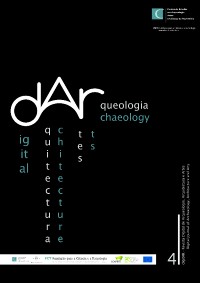Please use this identifier to cite or link to this item:
https://hdl.handle.net/10316.2/90795| Title: | Prospeção geofísica de vestígios de estruturas do antigo Paço Real de São Francisco (Évora), com uso de georradar e laser scanner | Other Titles: | Geophysical prospection of antique structural traces from São Francisco (Évora) Royal Palace with the use of georradar and laser scanner | Authors: | Oliveira, R. J. Caldeira, B. Borges, J. F. |
Keywords: | Geoarchaeology;applied geophysics;laser scanner;digital data processing;Geoarqueologia;geofísica aplicada;georradar;laser scanner;processamento de sinal | Issue Date: | 2017 | Publisher: | Imprensa da Universidade de Coimbra | Abstract: | n the place where currently there is the D. Manuel Palace, in Évora, will have been the Royal Palace of S. Francisco, one of the residences of the Portuguese monarchy between the sixteenth and seventeenth century. The building began to decline in 1616 and has been adapted to other occupations, abandoned and destroyed by fire. Between this building and the market there are archaeological remains, discovered during the execution of urban works. The current building was the result of several changes on what’s left, the last one on the front of its facade, which were removed monumental stairs that there is photographic record. This work intends to show the existence of ancient palace remains, integrated into the structures that currently exist within the research effective methods of application of geophysical techniques in Archaeology. To realize the goal, it proceeded to carry out geophysical prospecting with georadar, in areas adjacent to the palace, and with laser scanner, in order to integrate the results of georadar a three-dimensional representation of the current building. The results show the existence of structures that have corresponded to the palace staircase and remains consistent with the view that the palace would be extended to the side where there is the current market. No local onde atualmente existe o Palácio de D. Manuel, em Évora, terá existido o Paço Real de S. Francisco, uma das residências da monarquia portuguesa entre o século XVI e XVII. O edifício entrou em declínio em 1616, tendo sido adaptado para outras ocupações, abandonado e destruído por incêndios. Entre este edifício e o mercado existem vestígios arqueológicos, descobertos durante a execução de obras urbanas. O atual edifício foi o resultado de várias alterações sobre o que restou, a última delas na parte frontal da sua fachada, onde foram removidas umas escadas monumentais de que há registo fotográfico. Este trabalho pretende mostrar a existência de vestígios do antigo palácio, integrados nas estruturas que atualmente existem, no âmbito da investigação de metodologias eficazes de aplicação de técnicas geofísicas em Arqueologia. Para concretizar o objetivo, procedeu-se à realização de prospeção geofísica, com georradar, nas áreas adjacentes ao palácio, e com laser scanner, de modo a integrar os resultados de georradar numa representação tridimensional do atual edifício. Os resultados evidenciam a existência de estruturas que terão correspondido à escadaria do palácio e de vestígios compatíveis com a opinião de que o palácio se prolongaria para o lado onde existe o atual mercado. |
URI: | https://hdl.handle.net/10316.2/43054 | ISSN: | 2182-844X (PDF) | DOI: | 10.14195/2182-844X_4_7 | Rights: | open access |
| Appears in Collections: | digitAR: Revista Digital de Arqueologia, Arquitectura e Artes |
Files in This Item:
| File | Description | Size | Format | |
|---|---|---|---|---|
| prospecao_geofisica_de_vestigios_de_estruturas_do_antigo_.pdf | 2.63 MB | Adobe PDF |  |
Items in DSpace are protected by copyright, with all rights reserved, unless otherwise indicated.
